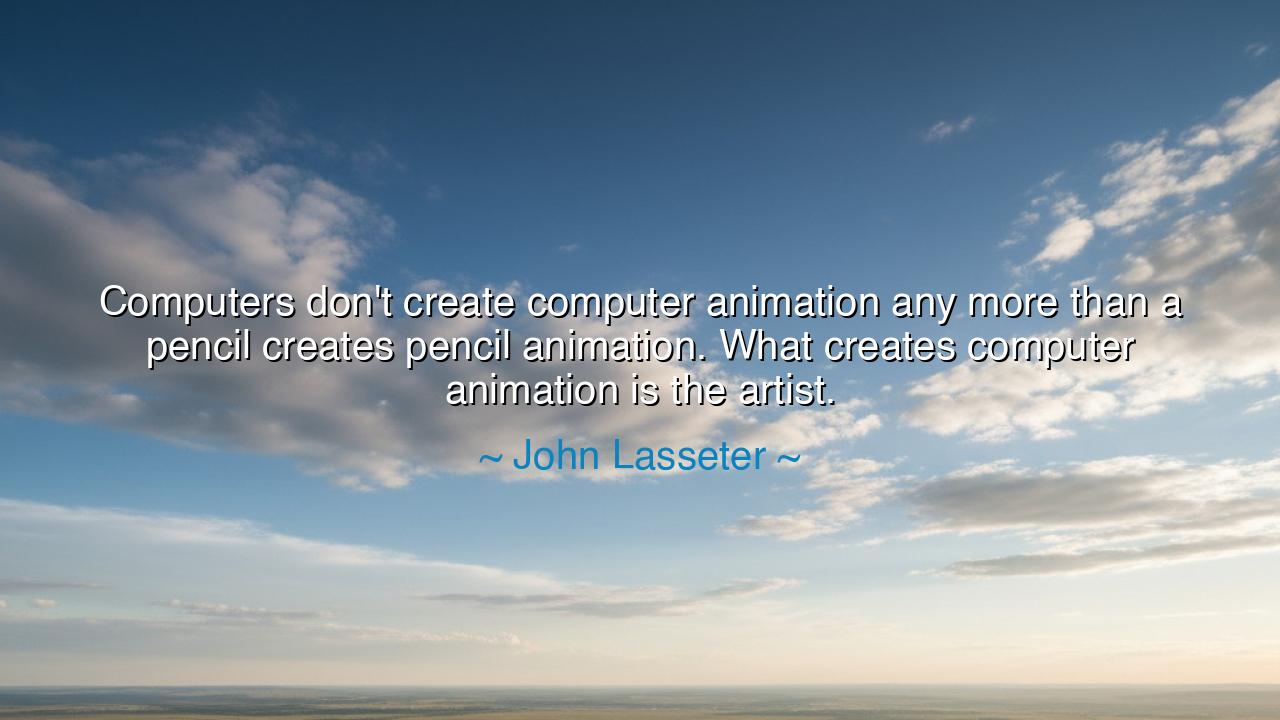
Computers don't create computer animation any more than a pencil
Computers don't create computer animation any more than a pencil creates pencil animation. What creates computer animation is the artist.






"Computers don't create computer animation any more than a pencil creates pencil animation. What creates computer animation is the artist." These words, spoken by John Lasseter, convey a timeless truth about the nature of creativity and the human touch behind every form of art. The tools we use—whether pencil, paintbrush, or computer—are simply instruments. It is the artist who breathes life into these tools, transforming them into something more than mere objects. Lasseter’s reflection on computer animation reminds us that technology is not the origin of art, but merely a medium through which human vision, passion, and creativity flow. The artist remains the true creator, guiding the machine to produce works of meaning, not the other way around.
In the ancient world, this idea was expressed through the concept of the muses, the divine forces believed to inspire artists, poets, and thinkers. The Greeks held that the artist was not merely a passive creator, but a conduit for divine inspiration. Just as Homer did not create The Iliad by mere technical skill, but by the flow of the muse’s inspiration, so too does the modern artist use the tools at their disposal—be it a canvas, a camera, or a computer—to express something greater than the sum of their parts. The tool, whether ancient or modern, does not create on its own. It is the artist’s vision and imagination that gives it meaning and life.
Consider the story of Michelangelo, who, when commissioned to paint the ceiling of the Sistine Chapel, faced an enormous challenge. His tools were rudimentary by today’s standards, and the task before him was not only physically demanding but artistically monumental. Yet it was Michelangelo’s genius—his ability to visualize and channel divine inspiration—that turned the project into one of the greatest works of art in human history. The scaffolding, paints, and brushes did not create the Sistine Chapel’s masterpiece; it was Michelangelo’s artistry that turned simple tools into a reflection of human divinity. Similarly, in today’s digital age, computers and software are but tools, while the true magic lies in the artist’s vision.
In the modern world, technology has brought new ways for artists to express their creativity. The rise of computer-generated animation in films such as Toy Story, the first full-length animated film created entirely with CGI, represents a new era in the intersection of technology and art. However, even in this groundbreaking achievement, it is the artists—animators, designers, storytellers—who breathe life into these digital tools. The machines may handle the technical processes of rendering and movement, but it is the human creativity that shapes the heart and soul of the animation. Without the artist, the computer would be nothing more than a tool, unable to create emotion or meaning.
Lasseter's words remind us that in all forms of creation—whether through brushstrokes, sculpture, or digital animation—the human element is essential. Technology, no matter how advanced, cannot replace the human imagination that drives art. The artist brings their unique perspective, experiences, and emotions to the process, transforming the tool into something alive, meaningful, and expressive. As Aristotle taught, art is not a mere imitation of nature, but a creative and interpretive act that transcends the material world. In the same way, animation is not just about the pixels and programs—it is about the vision and storytelling that only an artist can provide.
The lesson in Lasseter’s statement is that we must never underestimate the power of human creativity. Technology is a tool, but it is the human spirit that gives it purpose and meaning. Whether we are working with computers, paints, or words, the artist’s vision is the force that transforms a simple tool into a work of art. In our own lives, we must remember that our greatest achievements will not be defined by the tools we use, but by the passion, intention, and creativity that we pour into everything we do. As Lasseter emphasizes, it is not the tool that defines the art, but the artist who shapes the tool to their will.
In practical terms, this means that we must embrace creativity in all its forms and recognize that the tools at our disposal—whether digital or physical—are only as powerful as the vision that drives us to use them. Just as the great artists of the past used what was available to them, we too can use the tools of the modern world to express our creativity. Let us never forget that true art lies not in the tools themselves but in the hands that wield them, and that every creation begins with the vision of the one who dares to dream. Embrace your inner artist and use the tools at your disposal to shape the world around you.






AAdministratorAdministrator
Welcome, honored guests. Please leave a comment, we will respond soon